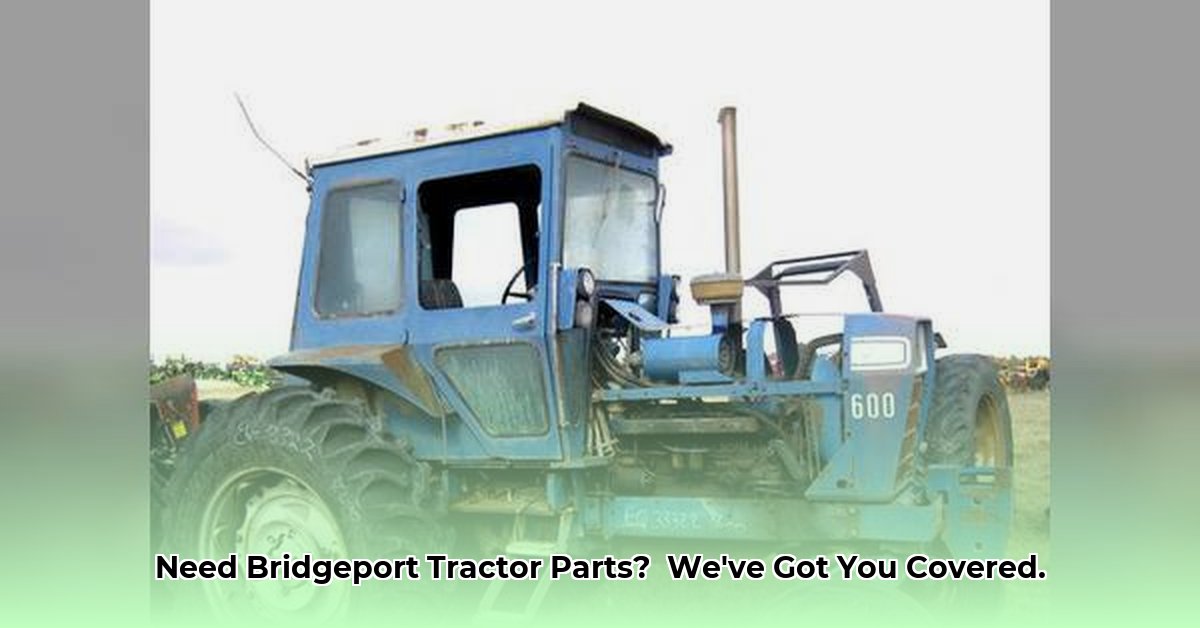
Keeping your farm equipment running smoothly is crucial for profitability, especially in challenging economic times. In the heart of Nebraska, farmers rely on resourceful solutions, often turning to used and rebuilt tractor parts to keep their operations afloat. This article explores the unique landscape of the Bridgeport, Nebraska, tractor parts market, offering practical advice for both farmers and parts suppliers. We'll focus on sourcing parts, maintaining equipment, managing costs, and adapting to the evolving world of precision agriculture. For additional resources on tractor parts, check out this helpful website: 3-point tractor parts.
The Bridgeport, Nebraska Tractor Parts Market: A Deep Dive
The demand for used tractor parts in and around Bridgeport, Nebraska, is strong, reflecting the entrepreneurial spirit of local farmers. Many prioritize repairing existing equipment over purchasing new machinery, leading to a thriving market for used and rebuilt components. Businesses like Bridgeport Tractor Parts and All States Ag Parts play a vital role in supplying this demand, serving farmers across western Nebraska, eastern Wyoming, and northeast Colorado. But this reliance on used parts presents challenges.
The High Demand for Affordable Parts
The high demand for affordable used parts underscores the economic pressures facing Nebraska farmers. Reusing parts keeps older, reliable equipment in operation, significantly extending its lifespan and reducing expenses. This cost-conscious approach contributes to the sustainable agricultural practices prevalent in the region. However, it also creates a competitive market, sometimes making it difficult to find specific parts for older models.
Navigating the Challenges of Part Availability
Sourcing parts for older or less common tractor models can be difficult. The limited supply of original parts for some older models highlights the importance of alternative sourcing strategies, often necessitating searching multiple suppliers. While some suppliers maintain extensive inventories from dismantled tractors, the availability of specific parts isn’t guaranteed.
Actionable Advice for Farmers: Maximizing Equipment Lifespan and Reducing Costs
For farmers, navigating the used parts market requires a strategic approach. Here's how to effectively source parts and keep your operations running smoothly.
1. Finding the Right Tractor Parts
- Diversify your suppliers: Build relationships with multiple suppliers, including Bridgeport Tractor Parts and All States Ag Parts, to increase your chances of finding the parts you need.
- Identify compatible parts: Research online resources to identify parts from different manufacturers that are compatible with your equipment, expanding your options.
- Thoroughly inspect used parts: Always inspect parts carefully for wear, damage, or safety hazards before installation.
2. Preventative Maintenance: A Proactive Approach
- Regular maintenance: Follow the manufacturer's recommended maintenance schedule to prevent costly breakdowns and extend equipment life. Even minor repairs should be addressed promptly.
- Address issues immediately: Small problems can quickly escalate into major repairs. Proactive maintenance is far more economical than reactive repairs.
3. Managing Costs Effectively
- Detailed budgeting: Create a dedicated budget for parts and repairs to track expenses and avoid financial surprises.
- Repair vs. replace: Weigh the costs of repairing versus replacing a part to determine the most cost-effective strategy. Consider the long-term value of each option.
- Explore financing: Look into financing options for major repairs to spread out costs over time, making large expenditures more manageable.
4. Adapting to Precision Agriculture
- Gradual adoption: Integrate precision agriculture technologies gradually, starting with smaller-scale implementations to assess their impact and benefits.
- Strategic upgrades: Prioritize upgrading older equipment components when necessary to adapt to precision agriculture's demands.
- Stay informed: Keep up with advancements in precision agriculture to make informed decisions about technology upgrades.
Actionable Advice for Parts Suppliers: Optimizing Operations for Success
The used tractor parts market is competitive. Suppliers can improve their operations and expand their reach by implementing the following strategies:
1. Streamlining Inventory Management
- Data-driven decisions: Analyze sales data to identify best-selling parts and those with longer lead times to optimize stock levels.
- Inventory management software: Utilize software to simplify inventory tracking and ordering, reducing time spent on administrative tasks.
- Rotate obsolete stock: Regularly review and remove parts that aren't selling to free up space and resources.
2. Building a Robust Online Presence
- User-friendly online catalog: Create a searchable online catalog with high-quality images and detailed descriptions to enhance customer experience.
- Mobile-friendly website: Ensure your website is accessible and functional on all devices.
- Online payment options Consider offering various online payment options to make purchasing parts for customers easier and more efficient.
3. Strategic Partnerships
- Collaboration: Explore partnerships with local repair shops, equipment dismantlers, or other parts suppliers to expand your reach and customer base.
- Community engagement: Build strong relationships with local farmers to strengthen brand loyalty and enhance trust.
- Expanding services: Offer repair services alongside parts sales to provide additional revenue streams and better serve your clients’ needs.
The Future of the Bridgeport Tractor Parts Market
The demand for used and rebuilt tractor parts in the Bridgeport area will likely remain robust. However, the increasing adoption of precision agriculture necessitates adaptation, requiring both farmers and suppliers to embrace innovation and balance cost-effectiveness with technological advancements. The future of this vital market will depend on the successful integration of new technologies while preserving sustainable and economic farm practices.